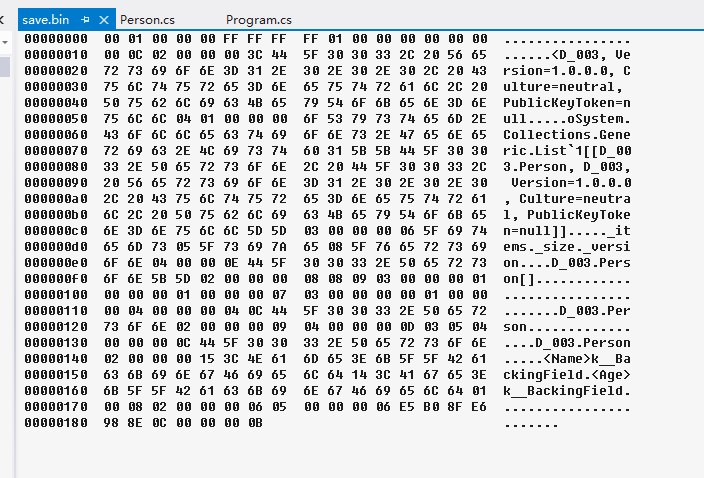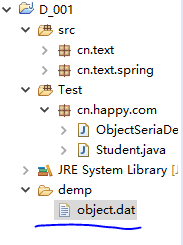将内存中的数据持久化到硬盘---序列化
将硬盘上的数据持久化到内存---反序列化
using System; using System.Collections.Generic; using System.Linq; using System.Text; using System.Threading.Tasks; namespace D_003 { [Serializable]//证明这个类是可被序列化的(类) public class Person { public string Name { get; set; } public int Age { get; set; } } }
using System; using System.Collections.Generic; using System.IO; using System.Linq; using System.Runtime.Serialization.Formatters.Binary; using System.Text; using System.Threading.Tasks; namespace D_003 { class Program { static void Main(string[] args) { #region 序列化 //List<Person> list = new List<Person>(); //Person p = new Person(); //p.Name = "小明"; //p.Age = 12; //list.Add(p); ////序列化器 二进制序列化器 //BinaryFormatter bf = new BinaryFormatter(); //Stream stream = new FileStream("save.bin", FileMode.Create); //bf.Serialize(stream, list); //stream.Close(); //Console.WriteLine("Ok"); #endregion #region 反序列化 Stream fs = new FileStream("save.bin",FileMode.Open); BinaryFormatter bf = new BinaryFormatter(); List<Person> list = (List<Person>)bf.Deserialize(fs); foreach (Person item in list) { Console.WriteLine(item.Name+""+item.Age); } fs.Close(); #endregion Console.ReadKey(); } } }

对象序列化
(1).对象序列化,就是将Object转换成byte序列,反之叫对象的反序列
(2).序列化流(ObjectOutStream),是过滤器----writeObject
反序列化流(ObjectInPutStream)---readObject
(3).序列化接口(Serializable)
对象必须实现序列化接口,才能进行序列化,否则将会出现异常
这个接口,没有任何方法,只是一个标准
(4).对象序列化就是保存对象
实际作用
序列化相当于加密,反序列化相当于解密,作用是方便储存和传输
序列化 (Serialization)将对象的状态信息转换为可以存储或传输的形式的过程。在序列化期间,对象将其当前状态写入到临时或持久性存储区。以后,可以通过从存储区中读取或反序列化对象的状态,重新创建该对象。
目的
1、以某种存储形式使自定义对象持久化;
2、将对象从一个地方传递到另一个地方。
3、使程序更具维护性。
案例
对象序列化
package cn.happy.com; import java.io.Serializable; /** * 对student对象进行序列化 * @author CY * */ public class Student implements Serializable{ /** * */ private static final long serialVersionUID = 1L; private String stuno; private String stuname; private int stuage; public Student(String stuno, String stuname, int stuage) { super(); this.stuno = stuno; this.stuname = stuname; this.stuage = stuage; } public String getStuno() { return stuno; } @Override public String toString() { return "Student [stuno=" + stuno + ", stuname=" + stuname + ", stuage=" + stuage + "]"; } public Student() { super(); // TODO Auto-generated constructor stub } public void setStuno(String stuno) { this.stuno = stuno; } public String getStuname() { return stuname; } public void setStuname(String stuname) { this.stuname = stuname; } public int getStuage() { return stuage; } public void setStuage(int stuage) { this.stuage = stuage; } }
package cn.happy.com; import java.io.*; public class ObjectSeriaDemo1 { /** * 对象进行保存 * @param args * @throws Exception * @throws FileNotFoundException */ public static void main(String[] args) throws Exception { //路径 String file="demp/object.dat"; //1.对象的序列化 /*ObjectOutputStream oos=new ObjectOutputStream( new FileOutputStream(file)); Student stu=new Student("1001","张三",20); oos.writeObject(stu); oos.flush(); oos.close();*/ ObjectInputStream ois=new ObjectInputStream( new FileInputStream(file)); Student stu=(Student)ois.readObject(); System.out.println(stu); ois.close(); } }

================================================================
package cn.happy.com; import java.io.Serializable; /** * 对student对象进行序列化 * @author CY * */ //序列化中子类和父类构造函数的调用问题 public class Student implements Serializable{ /** * */ private static final long serialVersionUID = 1L; private String stuno; private String stuname; private transient int stuage; //该元素不会进行jvm默认的序列化 也可以自己完成这个元素的序列化 public Student(String stuno, String stuname, int stuage) { super(); this.stuno = stuno; this.stuname = stuname; this.stuage = stuage; } public String getStuno() { return stuno; } @Override public String toString() { return "Student [stuno=" + stuno + ", stuname=" + stuname + ", stuage=" + stuage + "]"; } public Student() { super(); // TODO Auto-generated constructor stub } public void setStuno(String stuno) { this.stuno = stuno; } public String getStuname() { return stuname; } public void setStuname(String stuname) { this.stuname = stuname; } public int getStuage() { return stuage; } public void setStuage(int stuage) { this.stuage = stuage; } private void writeObject(java.io.ObjectOutputStream s) throws java.io.IOException{ s.defaultWriteObject();//把jvm能默认序列化的元素进行序列化的操纵 s.writeInt(stuage);//自己完成stuage的序列化 } private void readObject(java.io.ObjectInputStream s) throws java.io.IOException,ClassNotFoundException{ s.defaultReadObject();//把jvm能默认序列化的元素进行反序列化的操纵 this.stuage=s.readInt();//自己完成stuage的反序列化 } }
package cn.happy.com; import java.io.*; public class ObjectSeriaDemo1 { /** * 对象进行保存 * @param args * @throws Exception * @throws FileNotFoundException */ public static void main(String[] args) throws Exception { //路径 String file="demp/object.dat"; //1.对象的序列化 /*ObjectOutputStream oos=new ObjectOutputStream( new FileOutputStream(file)); Student stu=new Student("1001","张三",20); oos.writeObject(stu); oos.flush(); oos.close();*/ ObjectInputStream ois=new ObjectInputStream( new FileInputStream(file)); Student stu=(Student)ois.readObject(); System.out.println(stu); ois.close(); //并不是所有的对象都被期望序列化 } }
package cn.happy.com; import java.io.*; public class ObjectSeriaDem02 { /** * 创建对象的时候递归调用了父类的构造函数 * @param args * @throws Exception */ public static void main(String[] args) throws Exception{ /*ObjectOutputStream oos=new ObjectOutputStream( new FileOutputStream("demp/object.dat")); Foo2 foo2=new Foo2(); oos.writeObject(foo2); oos.flush(); oos.close();*/ //反序列化是否递归调用了父类的构造函数 /*ObjectInputStream ois=new ObjectInputStream( new FileInputStream("demp/object.dat")); Foo2 foo2=(Foo2)ois.readObject(); System.out.println(foo2); ois.close();*/ /*ObjectOutputStream oos=new ObjectOutputStream( new FileOutputStream("demp/object.dat")); Bar2 bar2=new Bar2(); oos.writeObject(bar2); oos.flush(); oos.close();*/ ObjectInputStream ois=new ObjectInputStream( new FileInputStream("demp/object.dat")); Bar2 bar2=(Bar2)ois.readObject(); System.out.println(bar2); ois.close(); /** * 对子类对象进行反序列化操作时 * 如果其父类没有实现序列化接口 * 那么其父类的构造函数会被显示调用 * */ } } //一个类实现了序列化接口他的子类都能实现序列化接口 class Foo implements Serializable{ /** * */ private static final long serialVersionUID = 1L; public Foo(){ System.out.println("foo..."); } } class Foo1 extends Foo{ public Foo1(){ System.out.println("foo1..."); } } class Foo2 extends Foo1{ public Foo2(){ System.out.println("foo2...'"); } } class Bar{ public Bar(){ System.out.println("bar'"); } } class Bar1 extends Bar implements Serializable{ public Bar1(){ System.out.println("bar1..."); } } class Bar2 extends Bar1{ public Bar2(){ System.out.println("bar2..."); } }